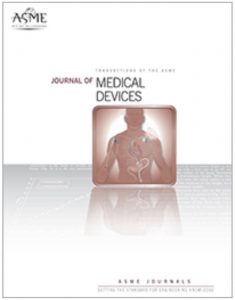Publications

A Method to Analyse Plantar Stiffness Variation in Diabetes Using Myotonometric Measurements
Authors: Shib Banerjee, Lakshmi Lasya Sreeramgiri, Hariram S, Srivatsa Ananthan, Ramakrishnan Swaminathan
Affiliations:
- Department of Applied Mechanics, IIT madras, Chennai, India
- Karuvee Innovations Pvt. Ltd., IIT Madras Research Park, Chennai, India
- Sree Clinic and Diabetic Centre, 20, Besant Ave Rd, Padmanabha Nagar, Adyar, Chennai, India
Journal: Journal of Medical Devices - March 2020, 14(1): 011105 (6 pages) (DOI: doi:10.1115/1.4045838)
-
Field & Applications:
- Medical
- Endocrinology
- Diabetes
Diabetes mellitus is a group of metabolic disease which has become globally prevalent, and affects a large population in socio-economically backward countries in Asian continent. Chronic diabetes can lead to ulceration in the plantar region and may result in amputation. Assessment of mechanical properties of plantar tissues can aid in early diagnosis of ulceration.
Myotonometry, a technique to measure dynamic stiffness is preferred due to its noninvasiveness, easy employability and rapid investigation. In this study, an attempt has been made to analyze the changes in soft tissue biomechanical properties of plantar surface in diabetes.
MyotonPRO, a handheld device, is used for this purpose. 43 diabetic subjects with varied duration of diabetes are recruited. Site-specific mechanical properties of the plantar region for both the feet are acquired and statistical analysis is performed.
Results show that the MyotonPRO is able to differentiate the stages of diabetes. It is seen that there is spatial variability in mechanical properties. Additionally, it is observed that there is a significant increment in the plantar stiffness value in the group with higher diabetic age (p < 0.05). Further, significant changes in dynamic mechanical properties is also observed in sub-metatarsal region. Additionally, a right-left asymmetry has been observed in frequency and stiffness values for later stages of diabetes.
This study demonstrated the feasibility of MyotonPRO in discriminating the stages of diabetic period. Thus, the proposed approach could be useful in early diagnosis of foot ulceration for various clinical conditions.
Diabetes is known to increase the overall stiffness of plantar aspect of foot due to structural change in the epidermal layers and collagenous network of plantar fascia. Analysis of mechanical properties of plantar regions plays a crucial role in diagnosis of ulceration, diabetic lesion, and clinical studies. Late diagnosis in ulceration may lead to amputation. Further, measuring dynamic stiffness of tissue using non-invasive technique is still a challenging task.
Myotonometery is a noninvasive techniques used to assess the biomechanical properties of tissue and is widely preferred for clinical studies. In this study, an attempt has been made to assess the dynamic mechanical properties of plantar regions using MyotonPRO, a handheld myotonometry-based device. Site-specific biomechanical properties of plantar regions are acquired from subjects with different duration of diabetes.
The results demonstrates that MyotonPRO is sensitive to the variation of biomechanical properties of plantar tissue at different stages of diabetes. The average stiffness has been found to be significantly high for groups with long (> 10 years) duration of diabetes when compared to groups of shorter diabetic age (< 10 years) [616.87 vs. 661.46 N/mm, p=0.01].
Increasing trend is observed in the frequency and stiffness values of submetatarsal regions. 1MST has demonstrated significant increment in stiffness in longer exposure of diabetes mellitus. In addition, an asymmetry is also observed in the frequency and stiffness values of left-right pair.
The results indicate that the MyotonPRO can be potentially used to enhance early diagnosis of ulceration. The future extension of this work will be a longitudinal study of the subject specific variation of biomechanical properties of plantar with prognosis of diabetes in close collaboration with the clinicians.


